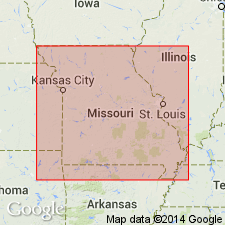
- Usage in publication:
-
- Blue Mound Shale Member
- Modifications:
-
- Named
- Dominant lithology:
-
- Shale
- Sandstone
- Coal
- AAPG geologic province:
-
- Forest City basin
- Lincoln anticline
- Iowa shelf
Summary:
Named as uppermost of three members of Shale Hill Formation (new) of Pleasanton Group for a settlement in southeastern part of T56N, R24W, Livingston Co, MO, in Forest City basin. Type section is in roadcut in NW1/4 NW1/4 sec 28, T56N, T24W, Livingston Co. Occurs in western and northern MO and possibly southern IA within Lincoln anticline and Iowa shelf. Lower part consists of Locust Creek coal bed (new), and an upper part of shale and sandstone. Coal beds are thin and impure, maximum thickness is about 2 1/2 ft; formerly called Ovid coal. Coal beds do not occur in westernmost counties of MO. Shale is gray to drab, maroon or gray-green, silty, and micaceous; basal part locally contains sparse marine fossils. Sandstone, called "upper Knobtown" by drillers, is well-developed in parts of western and northwestern MO. Average thickness of member is about 25 ft. Conformably overlies Knobtown Limestone Member of Shale Hill. Disconformably underlies Critzer Limestone Member of Hertha Formation of Kansas City Group. Correlation chart. Measured sections. Late Pennsylvanian (early Missourian) age.
Source: GNU records (USGS DDS-6; Denver GNULEX).
For more information, please contact Nancy Stamm, Geologic Names Committee Secretary.
Asterisk (*) indicates published by U.S. Geological Survey authors.
"No current usage" (†) implies that a name has been abandoned or has fallen into disuse. Former usage and, if known, replacement name given in parentheses ( ).
Slash (/) indicates name conflicts with nomenclatural guidelines (CSN, 1933; ACSN, 1961, 1970; NACSN, 1983, 2005, 2021). May be explained within brackets ([ ]).

